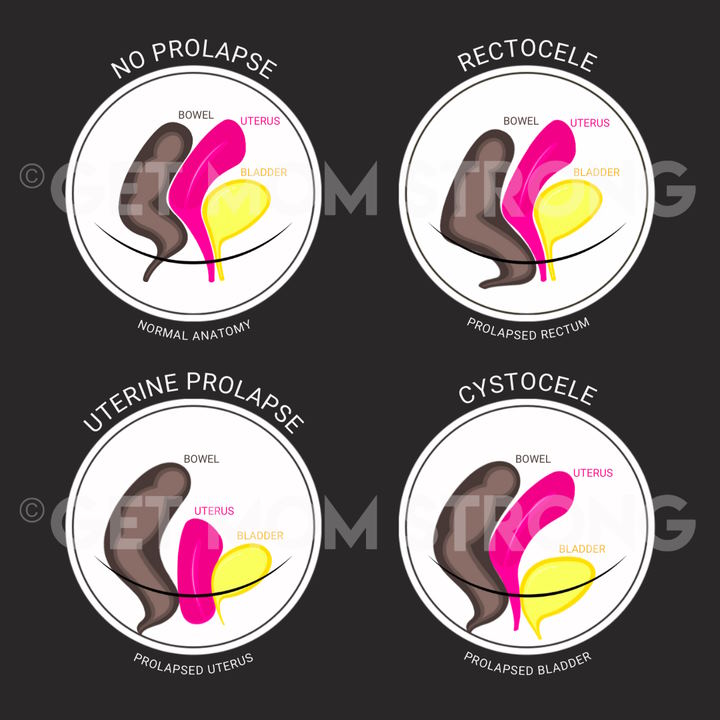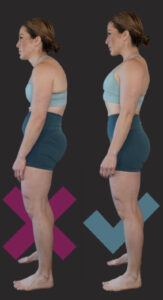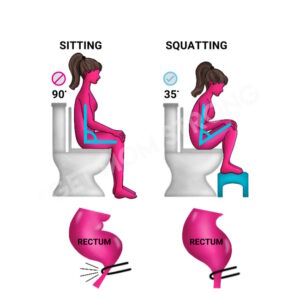If you have pelvic organ prolapse, you might be wondering if you can fix your prolapse without surgery. The good news is that you can absolutely improve your prolapse without surgery most of the time.
Prolapse occurs when one or more of the pelvic organs descends into the vaginal canal. It is a common occurrence among women, especially those who have experienced a vaginal birth. There are a few types of prolapse:
- Uterine prolapse
- Bladder prolapse
- Rectal prolapse
- Vaginal vault prolapse

There are treatments for pelvic organ prolapse that don’t require surgery. Proper body mechanics, pelvic floor muscle coordination, exercises and muscle releases can help treat your prolapse and improve symptoms significantly.
Lifestyle Changes and Everyday Posture
Healing a prolapse and minimizing symptoms takes a whole-body approach. Posture plays a huge role in pelvic health, particularly when it comes to prolapse.
According to Dr. Jennifer McGowan, pelvic floor physical therapist and owner of ReGenerate Physio, many women adopt a “butt-tucked” posture in pregnancy, which greatly impacts prolapse.
“During pregnancy, many women start to tuck their butt under to compensate for the growing belly. Studies have shown that this position allows your pelvic organs to descend more,” she explains. “Much of the time this posture carries over long after baby arrives, and it can exacerbate prolapse.”
Dr. McGowan goes on to explain that you can’t simply change your posture with mindfulness alone.
“You need to work on body awareness, but you also need to strengthen certain muscles and release other muscles to bring balance back to the body,” she says.
Often, returning to more neutral spine posture requires glute, hip flexor and core strengthening, along with hamstring and glute medius release work.

The Strong Like A Mother program focuses on these body mechanics to help relieve prolapse symptoms.
Untuck Your Butt
One simple shift in combating the butt-tucked posture is to stagger your stance and switch positions often.
It is much harder to hold tension in the pelvis when standing with one foot out and slightly bend at the knees.
Stop Sucking In
Many women, especially postpartum, suck in their tummy in hopes of hiding the postpartum belly pooch.
Sucking in actually makes a prolapse much worse. Your core is a pressure system. When you suck in, the displaced pressure has to go somewhere. Often, this pressure goes down, worsening prolapse symptoms.
Stop sucking in, wearing corsets, and overly tight clothing.
Carrying Kids
Kids can weigh a lot and it is common to fall into poor posture when holding babies and toddlers. One tip Dr. McGowan advises is to hold the child in the center of the body.
“You don’t want to create a shelf by either jutting your hip out or tucking and thrusting your hips forward,” she says. “Instead, keep the child in close to your body and consider wearing a baby carrier for more support.”
Get Fitted for a Vaginal Pessary
A pessary is a small silicone device inserted into the vagina and provides support for the vaginal wall, muscles, and tissues displaced by pelvic organ prolapse.
“Think of it like a sports bra for your pelvic muscles,” says Dr. Margo Kwiatkowski, an orthopedic and pelvic floor physical therapist. “It can give you the support you need so that you can work on strengthening the rest of your body without worrying about worsening your prolapse.”
A recent study actually found that using a pessary has many benefits and no side effects. The study found a reduction in prolapse symptoms, making it more likely to avoid surgery for pelvic organ prolapse eminently and long term.
According to Dr. McGowan, a pessary doesn’t need to be used all the time, but can be particularly helpful when performing heavy lifting, feeling symptomatic, or when an active day is ahead.
Learn to Manage Intra-Abdominal Pressure
Prolapse can be worsened from too much pressure on the pelvic floor, but the good news is– it can also be improved with more optimal core engagement.
Your diaphragm and pelvic floor work together. Ideally, as you inhale, the rib cage expands laterally and the pelvic floor gently relaxes. As you exhale, the pelvic floor naturally recoils.
Understanding this can make it easy to understand why holding your breath, especially when lifting things, can worsen a prolapse.
“That pressure has to go somewhere, and if you hold your breath…chances are it will go out or down,” says Dr. Kwiatkowski.
When lifting things (weights during a workout or picking up a kid), inhale down into the body as you bend down to lift. As you lift, exhale audibly out your mouth with a “haaaa” or “shhhhh” sound. This will help your pelvic floor lift to support the load.
Pelvic Floor Exercises to Improve Prolapse
In addition to learning to manage core pressure, there are a number of exercises to help strengthen the pelvic floor and surrounding muscles. Kegel exercises aren’t the answer for most. Instead, Dr. Kwiatkowski recommends whole-body exercises that are functional.
“You need to know how to use your core and pelvic floor in functional movements,” she says. “As moms, we are constantly bending over, picking up kids, and lifting things.”
It is important to focus on core breathing, and strengthening support muscles like the glutes, hip flexors, and inner thighs to bring about more pelvic stabilization.
Poop Mechanics Matter with Prolapse
If you struggle with prolapse, constipation is your worst nightmare. Healthy bowel movements and bathroom mechanics means less strain down on your pelvic floor and prolapse.
Dr. McGowan recommends using a potty stool like a Squatty Potty. This puts your body in a better position to excavate without straining.

Eat lots of fiber and stay hydrated.
“Examine your bowel movements. They should soft and formed, like a banana,” Dr. McGowan says. “You shouldn’t strain when going to the bathroom.”
If you do need to push to get your bowels out, she recommends exhaling gently as you push. Use a “shhhhh” or “fffff” sound.
She also warns about sitting on the toilet too long, concluding, “It should come out within a few minutes. If it isn’t coming out, get up and move along. Sitting and straining is not good.”
Can Postpartum Prolapse Heal Itself?
In some cases, prolapse symptoms can resolve or lessen after postpartum healing from childbirth occurs. For most, a proactive approach to healing is needed.
According to Dr. Kwiatkowski, postpartum prolapse might improve temporarily without intervention, but she questions what will happen with aging if left unresolved.
“What happens when you enter menopause?” she asks. “Coughing, constipation, and poor pressure management, coupled with hormonal shifts that can already compromise pelvic muscle integrity…it is a recipe for problems.”
Prolapse Hope Without Surgery
Most women can significantly improve prolapse without surgical treatment. There are many alternative treatment options including pelvic floor physical therapy and prolapse-centered exercise programs.
“Prolapse isn’t a disease, it is almost like saying you have a rotator cuff strain. It is a musculoskeletal strain and with time and training, we can reduce the symptoms,” says Dr. McGowan.
Strong Like A Mother (SLAM) has helped thousands of women improve prolapse symptoms without surgery.
